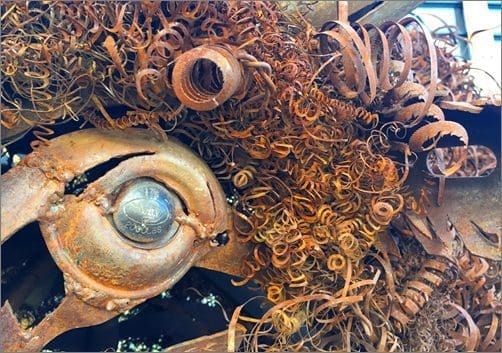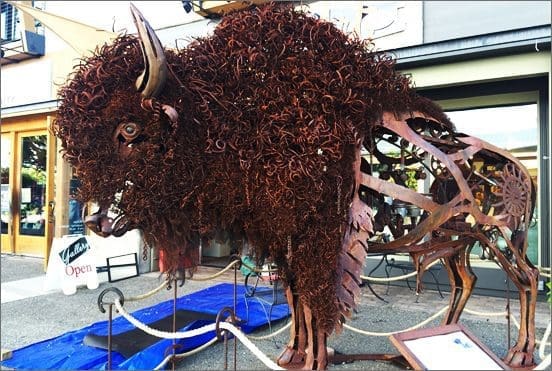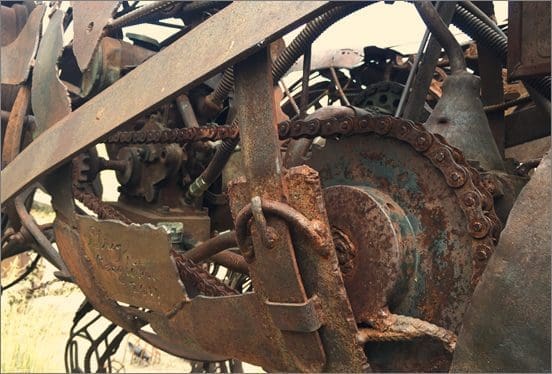On my way to meeting up with friends, I noticed a new piece of art in the Old Mill District. Close up, it’s not exactly what you would call pretty.

But take a step back and see what you see.
I knew instantly who the artist was. Greg Congleton. Because there is another of his steel sculptures in Farewell Bend Park.
Close up, it too is rusted junk.
Ah, but the big-picture view is this amazing creation of two horses pulling a log, depicting the earlier history of Bend as a logging town. Crafted from parts that no longer function as originally intended. Broken pieces. Pulled off a scrap pile. Old hinges, cogs, wrenches, gears. Parts of plows and golf clubs. Gear shift knobs and old saws. And horse shoes. Of course.
Hubby’s last few weeks with cancer looked something like those close-up views. Dysfunctional parts in his body. Some not-so-beautiful moments. Vomiting. Clogged nephrostomy tubes. Soiled diapers. Intense pain. ER visits (notice use of the plural). Infections. Confusion. Agitation. Struggling to communicate. Broken dreams as the pieces slipped through my fingers like so many shards.
Up close, not what you would call beautiful. But when I step back and look at the whole of our marriage and family, of all that was fashioned in us from the devastating losses — then I see beauty and usefulness:
1. Tougher perseverance with each piece of unwanted news.
2. Deeper love for each other as we journeyed this hard road together.
3. Greater appreciation of life and what was left after the dust settled with each disappointment.
4. Stronger faith with every act of grace and peace and provision as God reassured us, “I’ve got this.”
5. Better adventures as we made more fun and lived more intentionally during the cancer years.
This truth from the children’s book Tuck Everlasting by Natalie Babbit:
You can’t pick out the pieces you like and leave the rest. Being part of the whole thing, that’s the blessing.
I’m not too familiar with the welding process that takes all these scrap-heaped bits and fuses them together. But I do know it involves heat. Painfully high heat to create beauty from unwanted junk.
I have just one thing to say to that:
Don’t be afraid of the heat. Be afraid of no heat. Because no heat cannot transform your life into something of beauty.
Maybe the small-picture thinking in your life is centered around the daily grind of ordinariness. You wanted to do larger things than folding laundry, carpooling kids, and making the grocery budget stretch.
But what is the larger picture of creating a happy, functional home and family? I can answer that question from experience: It’s the pleasure of having kids and kids-in-law who are now your adult friends; the fun of smiling to yourself as they, now, deal with dirty laundry, paying bills, determining which dog ate the homework.
So, why get rid of small-picture thinking?
1. It doesn’t tell the full story. It only provides one tiny view of the whole.
2. Sometimes it’s not a pretty sight. Or perhaps it’s more accurate to say, “Oftentimes it’s not … “
3. It can seem broken. Dysfunctional. Of no conceivable value in and of itself.
4. It can be overwhelming. Painful. Devastating. Disheartening. Hopeless. (You fill in the blank.)
Whether you’re dealing with broken dreams or a broken relationship, the daily grind of the ordinary or a devastating diagnosis, take a step back and dare to imagine what possible gorgeousness can come from it.
Because there is a larger story for you to tell here.
What small-picture event currently clouds your big-picture vision? What can you do to clear your vision?
P.S. If you found this post to be interesting or helpful, please share, pin or tweet!




Leave a Reply